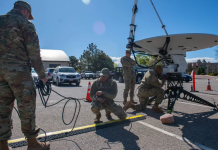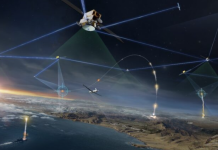The Pentagon has spent many years regarding the space domain as a “sanctuary” for international cooperation, scientific exploration, and discovery, for both the future of mankind and global partnerships.
This DoD stance was maintained for many years, for both ethics and future society, yet many great power rival nations have spent recent years aggressively weaponizing the space domain. China has been testing and firing Anti-Satellite (ASAT) weapons for at least ten years, and both Russia and China continue to take ambitious steps to increase space war capability.
Given the severity of this threat circumstance, the Pentagon has in more recent years accelerated an effort to ensure the US can defend itself if needed in the realm of space. Of course, this includes satellite connectivity, the addition of hundreds of high-throughput Medium and Low-Earth Orbit satellites and even the possibilities for lasers, optical communication, space drones and manned spacecraft war platforms.
Given the threat equation and potential technological sensitivity of spacewar systems, many details may not be available for security reasons. This being said, there is an evolving robotic space vehicle now being developed more fully for both scientific and military purposes with large-scale Air Force involvement.
An attack space drone may sound a bit like a vessel from Star Wars, but it might actually be possible in the real world, based on a space “drop” and the successful flight of Boeing’s X-37 robotic spacecraft.
Called the Orbital Test Vehicle, the space robot is thrust into space by a launch vehicle and then lands as a space vehicle upon re-entering the atmosphere.
X-37B: What We Know Right Now
In the most recent test, the U.S. Space Force’s X-37B successfully de-orbited and landed at a NASA facility at Kennedy Space Center in November of 2022, according to an essay published by U.S. Space Force News.
Just a Big Experiment or Something More?
Beginning as a NASA project, the OTV has primarily been an exploratory scientific mission to study the details and limitations of space flight. Its promise for military use, however, more fully involved the Pentagon as the technology matured. Now, with this most recent success, the X-37B variant is essentially operating as if it were a space drone, able to conduct surveillance, gather data from beyond the earth’s atmosphere, and potentially be adapted into an armed military platform.
In purely scientific terms, researchers have used the X-37 to conduct experiments with solar energy and “reusable” space technologies able to perform a wider range of missions than a missile interceptor of some kind. A data sheet on the OTV from the U.S. Air Force says the X-37 uses Gallium Arsenide Solar Cells with Lithium Ion batteries.
X-37B: A Weapon?
The possibilities with this kind of progress seem limitless when it comes to military use, given the rapid advances in autonomy, AI-enabled data collection and analysis, and multi-domain networking.
Specifics regarding the X-37B’s test missions and military capabilities are likely unavailable for security reasons. Yet, indeed, one cannot help but wonder about its potential lethality and military mission ability based on the successful duration of its most recent flight.
What the Future May Hold
The proliferation of Medium and Low-Earth Orbit satellites is intended to increase throughput, build in redundancy, and better enable hypersonic missiles defenses to establish a continuous “track” of an enemy threat as it quickly transits from one radar aperture field of regard to another. A mobile spacecraft would of course immeasurably help this effort, particularly if it could use various kinds of datalinks, GPS signals, or even optical communication to send real-time information to human decision-makers exponentially faster.
An evolved X-37B could, for instance, potentially defend satellite assets from enemy ASAT or anti-satellite weapons. Also, if pursued in an ethical manner consistent with the Pentagon’s “human-in-the-loop” doctrine related to the use of lethal force, the X-37B could potentially destroy enemy satellites or targets from attack locations beyond the Earth’s atmosphere.
However, Russian and Chinese efforts to militarize space put the U.S. at a significant deficit, creating a need for the Pentagon to close the gap, build a U.S. Space Force and prepare to defend the US from space if necessary moving into the future.
Kris Osborn is the Military Affairs Editor of 19FortyFive and President of Warrior Maven – Center for Military Modernization. Osborn previously served at the Pentagon as a Highly Qualified Expert with the Office of the Assistant Secretary of the Army—Acquisition, Logistics & Technology. Osborn has also worked as an anchor and on-air military specialist at national TV networks. He has appeared as a guest military expert on Fox News, MSNBC, The Military Channel, and The History Channel. He also has a Masters Degree in Comparative Literature from Columbia University.





